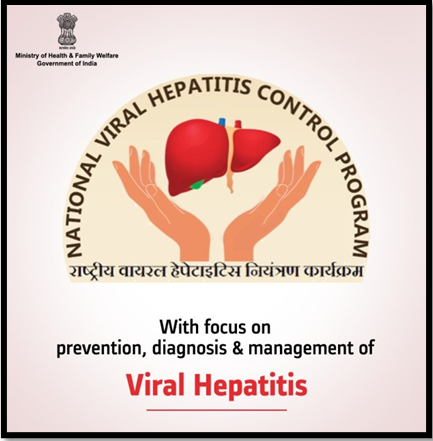“ADDRESSING THE GLOBAL BURDEN OF VIRAL HEPATITIS”
Syllabus:
- GS-3 – Health and related technological advancement
Focus :
- Overview of the World Health Organization’s (WHO) Global Hepatitis Report 2024.
- Highlighting India’s significant contribution to the global hepatitis disease burden.
Source- MHA
Key Findings from the Report
- Statistics on the prevalence of viral hepatitis worldwide- India accounted for 6% of the total
viral hepatitis disease burden globally in 2022, making it the country with the second highest disease load after China, according to the World Health Organization’s (WHO) Global Hepatitis Report 2024 released recently. Bangladesh, China, Ethiopia, India, Indonesia, Nigeria, Pakistan, the Philippines, the Russian Federation and Vietnam, collectively shoulder nearly two-third of burden .
Understanding Hepatitis and its Strains
- Definition of hepatitis as liver inflammation caused by infectious viruses and non-infectious agents.
- New data from 187 countries show that the estimated number of deaths from viral hepatitis increased from 1.1 million in 2019 to 1.3 million in 2022.
- Of these, 83% were caused by hepatitis B, and 17% by hepatitis C. Every day, there are 3,500 people dying globally due to hepatitis B and C infections.
- Half the burden of chronic hepatitis B and C infections is among people aged 30-54 years old, with 12% among children under 18 years of age. Men account for 58% of all cases.
- Explanation of the five main strains of hepatitis virus (A, B, C, D, and E) and their differences.
- Emphasizing the chronic nature of hepatitis B and C and their severe health consequences.
| About Hepatitis-
Types of Hepatitis Viruses: Hepatitis A Virus (HAV)
Hepatitis B Virus (HBV)
Hepatitis C Virus (HCV)
Hepatitis D Virus (HDV)
Hepatitis E Virus (HEV)
|
Factors Contributing to India’s Vulnerability
- Analysis of reasons for the high prevalence of hepatitis in India, including population density and lack of awareness.
- Discussion on the role of chronic viral infections, non-viral forms of hepatitis, and high-risk behaviors.
- Insights into the challenges faced in diagnosing and treating hepatitis in India.
Prevention and Treatment Strategies
- Importance of hepatitis B vaccination and availability of curative treatment for hepatitis C.
- Comparison of the cost of treatment in India with other countries, highlighting the affordability of generic drugs.
- Overview of the government’s viral hepatitis control program and its initiatives for prevention and treatment.
Government Efforts :
|
Significance of the WHO Report
- First comprehensive report on viral hepatitis epidemiology, service coverage, and product access.
- Analysis of global progress in diagnosing and treating hepatitis, highlighting areas of improvement.
- Importance of the report in guiding public health policies and interventions to achieve the WHO’s targets by 2030.
Challenges and Opportunities for the Future
- Addressing mother-to-child transmission and ending discrimination against hepatitis patients.
- Overcoming pricing disparities and ensuring equitable access to affordable medicines.
- Recommendations for expanding access to testing, strengthening prevention efforts, and increasing funding for hepatitis programs.
Conclusion
- Recap of the key findings and recommendations from the WHO report.
- Call to action for governments, healthcare providers, and international organizations to work together to eliminate viral hepatitis by 2030
Source:The Hindu
Mains Practice Question :
GS-3
Discuss the findings and implications of the World Health Organization’s Global Hepatitis Report 2024, highlighting the challenges and opportunities for addressing the global burden of viral hepatitis.(250 words)




